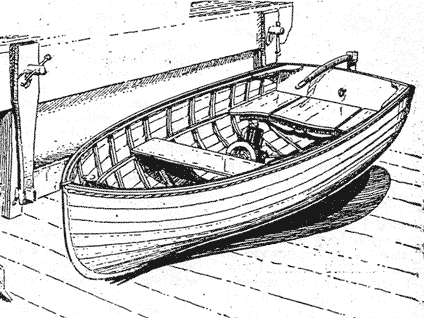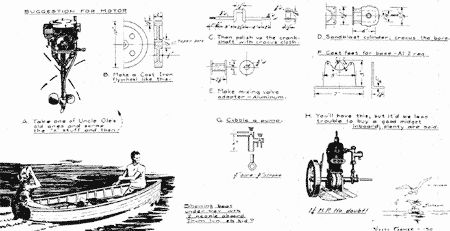|
A Small Boat with a Large Background
(reprinted from "The Rudder")
THIS little ship is a love affair designed for the
winter fireside and the spot by the laundry tub.
You will dream of her by the fire. You can build
her by the tub. She is wee and yare, and is presented
here as the smallest inboard of the year.
You see, it's this way. A guy sees all kinds of
designs in this spiffy family journal. Big yachts, medium
yachts, yachts you'd love to own providing you were
major stockholders in Coca-Cola.
They've got that very real sex appeal that comes
from having quality in definite quantities and curves
where curves belong. Once in a while you get aboard
such a boat. And every now and then one of these
floating saloons will have something in davits that more
nearly hits the. spot—a little dinghy, built like a watch
and powered by a jeweled internal combustion infant
that does things to your heart.
But did you ever see plans for that kind of a dinghy?
I hadn't either. Who designs 'em? Who builds 'em?
Many a dinghy I've seen was a better building job than
the parent ship. Just plain "cunnin', honey" But who
does 'em? Where do they come from? What's their
story?

I'd been puzzled by this phenomenon, the social relationship of the dinghy to the above questions, when of
a sudden the answers were laid before me. It was at
Elco, in Bayonne, when I learned the Life Cycle and
Genesis of Legitimate Dinghies of the Upper Classes.
If you can stay with a moderate dose of personal pronoun, I'll guarantee that by the end of this backwards
yarn your muse will have been titillated. You will see
that good dinghies are not brought by the stork.
The best thing about Bayonne is that it gets a guy
away from Jersey City. Jersey City is a dump. You
have to go through it, if on wheels and from any part
of the United States you want to get to Bayonne. Now
the nice thing about Eico is, or was, that working at
Eico you could forget Bayonne. It was a sort of Tinkers
to Evers to Chance escape from reality. Jersey City to
Bayonne to Eico—all! The Cadillac ot the yacht building
industry. There, for a portion ot the war years, I headed
up the yacht design department, or what was left of it
after the Old Standbys flocked to the PT boat department. In yachts, the "department" consisted of myself
and Henry W. Uhle III. Hank Uhle was then on his
first tenure as a naval artichoke. I was on my eighteenth.
I sensed in Hank a very competent chaftsman, a likable
disposition, and an art in the appreciation of boats that
is given to only the gifted few. Hank was a kindred
soul.
In the ten o'clock glare of an icy, uncomfortable
February morning Hank and I were crawling with
frozen hands and with pencils in chattering teeth through
the bowels of an old lifeboat that had been converted into
a yacht and which had been thoughtfully laid up where
the morning's charming hurricane could blow through every seam. It was colder than charity, We were measuring the old pot's lazarette for a set of bunks.
"Bunk is the word for it," I said to Hank. "The
hell with it. Let's play hookey and drop into the joiner
shop for some coffes. C'mon, Mr. Uhle, one two three."
''G-j-j'-jeez !" chattered Hank. He always was a
wordy cuss. "G-J-j-Jeez!"
Which found us in Jess' joiner shop—in the old
original Eico building. There Ferris, C. G. Davis,
Charley Lamont, lrwin Chase. Glen Tremaine, Bill Fleming" and other famous names had turned out some honeys
—Alcatorda, Alerion—the pedigree of this shop was
endless. No artist with an ounce of sensitiveness could
have missed the romance shed by the shop that morning. The sun, the hiss of steam, the smell of cedar.
And Jess, the Joiner boss at Eico, made such swell
coffee!

Then Hank and I both saw it at the same time. I
knew where good dinghies got their pedigree. There
in one corner of the joiner shop a midget set of stocks
was set up. A Scotsman with more yards of cedar
shavings behind him than I ever saw was giving birth
to a little dinghy.
It was something to watch. He set up the stem and
keel. The stem flowed in one of those curves that can
come only from a workbench, not a drawing board, and
the rabbet followed the grain of the hackmatack perfectly. The rabbet was hand cut, but looked machined.
The molds went in, zip, zip, and out of the steam box
came the garboards. While we sipped a cup of coffee
the garboards and broads went on! The Scotsman was
a conductor, and he was playing a symphony in wood.
These old country, men bring an integrity to their
craft that is sadly lacking over here these days. Over
there they have to earn their way to competence by
serving four years at grueling tool work before they
are journeymen. Their knowledge of wood and what
it will do is unequaled. Watching this gent, I was glad
I'd been through the same aipprenticeship, because I
could appreciate his great skill.
She was such a prettv little dinghy! And Scotty had
her planked that day, and had her framed the next morning, and took his own darned sweet time thereafter in
"finishing"—breasthook, risers, wales and seats. His
particular dinghy was not powered, but I spent endless
hours "palming" her measurenients, vowing one day to
bring such a little ship to printed page for posterity.
And if possible to power her, so that ship to shore communications could be established without worrying about
a kicker in a seaway.
Which is what we have in Irreducible here. And
now that you have learned that these Upper Clarse
dinghies usually come from the hands of some obscure
shipwright who has a feel for boats, and revels in his
ability to wind wood where he wanteth, observe then these plans for the first powered dinghy that has appeared in a
coon's age.
She is ten feet long. She is clinker planked, as all cedar dinghies should be, for they can be dunked and hauled at will without checking seams open. Irreducible has been designed
as a pretty little power boat, not a hog waisted scow. Two people are about her maximum load, and one man can have
endless hours of fun just running her. The scantlings are on the plan. and it is not in the province of this story to tell you how to build her.
I have designed her for low power. You can install an air
cooled job for a motor if you want. As for me, this design
is a labor of love, and in a boat I want a water cooled engine,
with steam softened bark, and plenty of flywheel so I can think faster than the engine can. I show how one of Ole Evinrude's
originals, which now are quoted at from one to ten bucks per
carcass, can be rejuvenated for about ten bucks to make a good, easy starting, low pressure inboard. The secret is in a bigger flywheel, which is easy to cast, in getting plenty of grease to
the main journals through the use of grease cups, and the use
of a spark coil and hot shot for ignition. Just turn 'em until
they run. That's all there is to it!

Suggestions for a motor (click for larger view)
I have converted two of Uncle Ole's own. The first one
retained the knuckle buster crank and magneto. She was non-pareil at holding up the legend of being hard to start. So I heaved the magneto out and put on a stick timer (see drawing) and a cast iron flywheel.
The next one I added some more hunker to the flywheel, and cast the base legs out of aluimnum, also making an advance
of aluminum for the mixing valve intake. This spool has the
advantage that you can hacksaw and file the manifold largely
where you want it, and after setting the engine in, can
set the angle of the mixing valve, which should be set approximately level when running. Bear in mind that a two port engine
such as this is flooded before you try to start her. Just turn
the ignition off, draw in a charge in the base, roll her
more to get the charge into the cylinder, then turn on the
juice. She'll start every time. And with a beefy flywheel, you
can shut off the juice, let her roll nearly to rest, flip the timing,
turn on the juice, and you are in reverse. Steamboating this
way is fun.
In the right boat, with the right man running them, four
cycle chunker-lunks are positively pluperfect. And with such a
mill Irreducible will get you out to the anchorage every time
on time if you know when to leave shore.
Comments: (sorry, closed due to spamming)
George 01 Jan 06 06:50Our local dump seems to always have a supply of dead garden tractors around. They have simple transmissions and occasionally a working engine. Just keep looking, or talk to the man behind the counter at the dump
Scott Calman 06 Dec 05 14:51Good place for old small motors is your local lawnmower shop. The one by my house has a wall of maytags. I would like to know more about canadian "make or break" motors though
tidmarsh 06 Dec 05 08:01How about electric power? Scavenge a motor and controller from an old golf cart and stick a couple of batteries under the middle thwart--quiet & smooth.
Dave 06 Dec 05 07:10You may be able to find one of the old single cylinder make or break engines that used to be manufactured in Canada. There should still be a lot of them around. I think that I'd probably go with a 5-8 HP Briggs and Stratton with the 6:1 reduction gear built in. You can find those just about anywhere and they are fairly inexpensive. The main problem with using one of them is that there is no economical way -- that I am aware of -- to get reverse or neutral. Some people have used pully arrangements to jack-leg a neutral and reverse but I have yet to see such an arrangement that I feel is safe enough under all conditions.
John trussell 06 Dec 05 06:24
All these entrancing plans for low speed inboard boats; where does one find low speed, small, inboard motors?
|
|